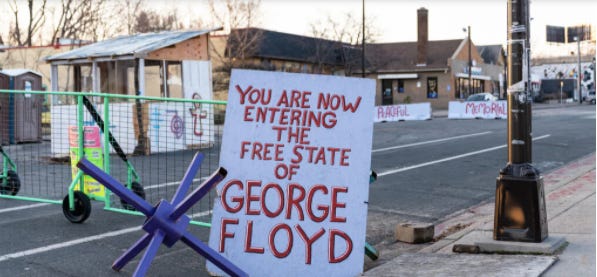In the trial of Derek Chauvin, which started Monday, prosecutors opened by showing a 9-minute-29-second video of the last moments of George Floyd’s life.
On May 25, 2020, Chauvin, then a Minneapolis police officer, kneeled on the neck of Floyd, who was taken into custody on suspicion that he’d just passed a counterfeit $20 at Cup Foods, a corner market. Chauvin kneeled there for so long that a Minnesota 911 operator worried that the camera feed had frozen. Even with an ambulance pulling up behind him, Chauvin did not rise.
Three other officers — who with Chauvin were fired the day after Floyd died — have also been charged. Earlier this month, the Minneapolis city council approved a $27 million settlement to the Floyd family. His murder sparked a worldwide protest.
Prosecutor Jerry W. Blackwell, who is working pro bono on the case…
broke down the timing of Chauvin's kneeling into three sections: 4 minutes and 45 seconds as Floyd cried out for help, 53 seconds as Floyd's flailed due to seizures and 3 minutes and 51 seconds as Floyd was non-responsive.
The harrowing video shows, at different times Floyd on the ground beneath Chauvin’s knee at 38th and Chicago saying he couldn’t breathe. He asked for water. He called for his (deceased) mother. He cried out. People began gathering, and they spoke to both Floyd and the police in ever-more-frantic tones:
Check his pulse, bro.
Get up and get in the car, man. You can’t win. You can’t win, man.
You could at least lift him up off the ground.
Perhaps the most compelling witness for the prosecution (so far) is Donald Williams II, 33, a mixed martial arts competitor who has trained with Minneapolis police officers. On the day Floyd was killed, Williams had driven to the market — which Floyd had just exited — to buy something to drink after a day of fishing. Rather than going into the store, Williams moved to where Floyd was held on the ground by Chauvin. On the stand, Williams matter-of-factly, eyes down, explained what he heard from Floyd, the pleas for help, the cries.
On that day last year, Williams said to Chauvin that he was holding Floyd in a “blood choke.” In fact, that day’s most-circulated photo was, Williams said, when a passerby took video of Chauvin as he looked up in response to Williams’ blood choke statement.
Williams said he called for Floyd’s pulse to be checked, multiple times. He countered when one of the officers, Tou Thao, told the crowd, “This is what drugs do to you.” No, it isn’t, Williams said. On the stand, Williams described a “shimmy,” a move to tighten a choke, which Williams said he saw Chauvin perform several times, and he walked the jury through that last awful video to show them what he meant.
Throughout the first day, defense attorney Eric Nelson tried to say that the crowd diverted the police officers’ attention and interrupted their ability to tend to Floyd, though crowd control is included in even the most basic of police training.
Chauvin is charged with third-degree and second-degree murder, and second-degree manslaughter. The trial, which is expected to last a month, is being watched by people around the world. As Keith Mayes, associate professor at the University of Minnesota’s department of African American and African studies, said:
Everything is riding on the outcome of the trial.






I hope for accountability (justice - but that word even feels insufficient). I fear there won't be. I can't watch. 😥
Thank you for this account of horror. :(